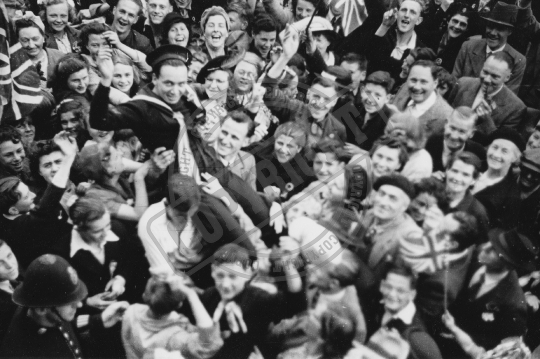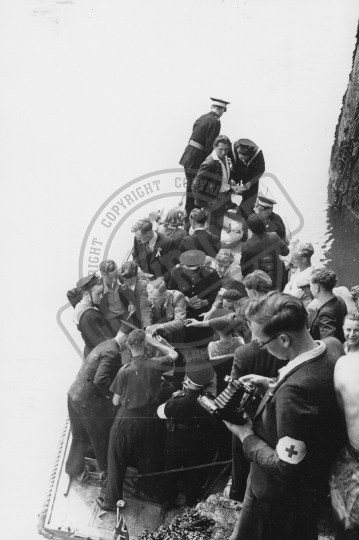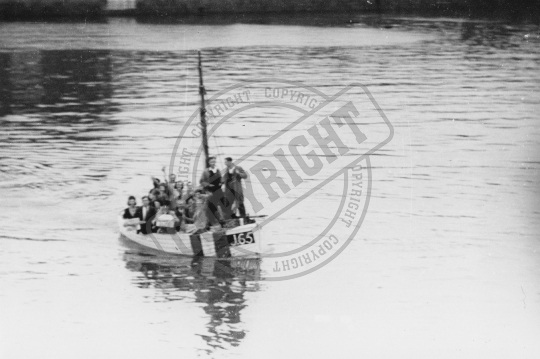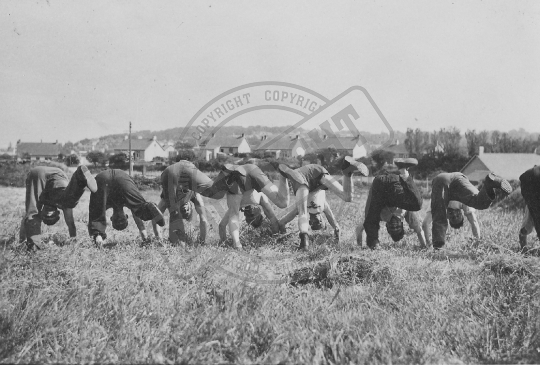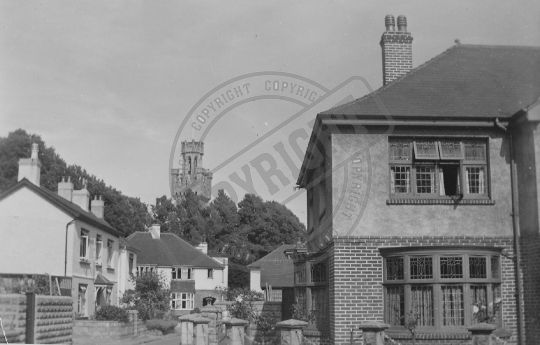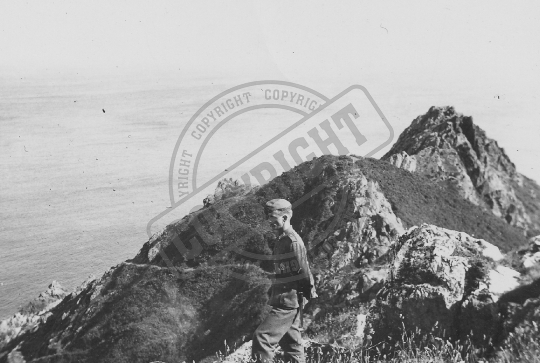Results (319)
CIMM_0071
Jersey Friday 11th May 1945. The Royal Court’s first sitting since the Liberation of Jersey assembled at 11 a.m. on Friday morning, 12 May 1945. In attendance were Force 135 officers including L to R; Captain C. Hargreaves, Major Anderson, making their way through the streets of St Helier to the Court.
CIMM_0069
Jersey Thursday 10th May 1945. After the speeches the St James Boys Brigade Band, headed by Dae Donavan their drum-major, struck up a rousing march and marched out of the Royal Square followed by Lt-Col Robinson and the troops that had formed the Guard of Honour.
CIMM_0068
Jersey Thursday 10th May 1945. The Guard of Honour and the Islanders wait patiently in the Royal Square for the States Members to arrive for the Hoisting the Flag Ceremony. Lt-Col. Robinson, deep in thought, paces the pavement outside the States Buildings.
CIMM_0067
Jersey Thursday 10th May 1945. The section of crowd at the Pierson Hotel end of the Royal Square wait eagerly for the ceremony to begin.
CIMM_0066
Jersey Thursday 10th May 1945. The Guard of Honour is marched off the Weighbridge led by Lt-Col Robinson and followed closely by Captain Le Brocq.
CIMM_0065
Jersey Thursday 10th May 1945. The Guard of Honour is handed over to Lt-Colonel W. P. A. Robinson, MC, RA, the Island Commander, Jersey and Commanding Officer 620 Regiment, Royal Artillery. Captain Hugh Le Brocq is on the right.
CIMM_0064
The Guard of honour for Hoisting the Flag Ceremony on the morning of Thursday 10th May 1945 are inspected by the CSM on the Weighbridge in front of the Pomme d’Or Hotel, which will become Force 135 Tactical Headquarters.
CIMM_0063
Jersey Thursday 10th May 1945. Jerseyman Corporal Alex Mangan was kept busy signing autographs for islanders in Conway Street, St Helier.
CIMM_0062
Jersey Thursday 10th May 1945. Three Jersey lads, Private Raymond Ahier, Sergeant Winter de Gruchy, and Corporal Alex Mangan, serving with the 11th (RMIJ) Battalion, the Hampshire Regiment, in Broad Street, Jersey.
CIMM_0060
Jersey Liberation Wednesday 9th May 1945. Islanders crowded onto the LCI(L) 130 and asked the crew for autographs.
CIMM_0058
Jersey Liberation Wednesday 9th May 1945. Once moored alongside the New North Quay crew members of one of the HM Motor minesweepers relax after clearing the approaches to St Helier Harbour. This minesweeper is most probably the FY PT 542 commanded by Lieutenant Idris Edwards, RNVR.
CIMM_0055
Jersey Liberation Wednesday 9th May 1945. One of two sentries that were posted to guard the mooring ropes, maintain discipline and ensure security of the vessel to prevent over enthusiastic islanders boarding the LCI(L) 130 and removing items as souvenirs.
CIMM_0054
Jersey Liberation Wednesday 9th May 1945. Officers of LCI(L) 130 with a Royal Engineer Major (third left) from the 'Omelette’ Advance Party. L to R; First Lieutenant (name unknown), RNVR; Sub.Lt. Jimmy Cooper, RNVR; and Commanding Officer, Lt Charles Sanders, RNVR.
CIMM_0053
The LCI(L) 130 moored alongside the New North Quay, St. Helier Harbour, Jersey. Almost immediately the main 'Omelette’ advance party of some 200 men began to land at 5pm on Wednesday 9th May.
CIMM_0051
Three British soldiers guard the main gate at Fort Regent to prevent Jersey islanders from entering. John Langlois is the small boy on someone’s shoulders waving the Red Ensign, son of Fred and Mary Langlois. Third from left is 16-year-old Dennis Perrier.
CIMM_0050
A Royal Navy rating from HMS Beagle’s launch is also given a hero’s welcome by a group of Jersey islanders outside the Harbour Office at the Weighbridge.
CIMM_0046
The launch from HMS Beagle was swamped with autograph hunters at the end of the Albert Pier, Jersey. The sailor's supply of cigarettes rapidly diminished.
CIMM_0044
Everyone on the Albert Pier in Jersey wanted their photograph taken with the first Liberators ashore. L to R: Miss Betty Richomme, Miss Haines, St John Ambulance Nurses back row unknown, Mary Martret, Margaret Sewell, Surgeon-Lieutenant Ronald McDonald, Miss Frazer, Sub-Lieutenant David Milln, unknown, Maurice Gautier and Major V. Cooke.
CIMM_0042
View looking across St. Aubin’s bay, Jersey from St. Helier Harbour. HMS Beagle can be seen at anchor behind Elizabeth Castle breakwater. One of the two square bunkers housing the firing points for the electrically detonated mines laid in the approaches to the harbour can be seen at the root of the castle breakwater.
CIMM_0040
One of the small boats that had made the trip to HMS Beagle anchored in St Aubin’s Bay, Jersey. On returning to St Helier Harbour two on board are holding up copies of the previous day’s newspapers announcing VE-Day, thrown to them by sailors on board the destroyer.
CIMM_0039
Jersey ex-political prisoners taken shortly after their release from the Newgate Street Prison. Left to Right: Bunny O’Neil, Mr. Rondel, Charles Gruchy, Martin Le Cornu, Hugh Le Cloche, Basil Thornton, the Dutchman Siebe Kosta, and John Bisson.
CIMM_0038
The RM Stores in King Street, St. Helier, Jersey featured the big three. Stalin, Churchill, and Roosevelt, with 'Winnie’, standing on a map of Jersey, holding up Hitler by the seat of his breeches.
SP_0048.jpg
The gun crew of Flak Batterie Kapellendorf located off Les Grandes Capelles in St Sampson. This battery of four 8.8cm Flak 18 guns which were used in an anti-aircraft role. This sequence of photographs were taken in December 1941. Note the kill markings on the gun barrel.
SP_0047.jpg
The gun crew of Flak Batterie Kapellendorf located off Les Grandes Capelles in St Sampson. This battery of four 8.8cm Flak 18 guns which were used in an anti-aircraft role. This sequence of photographs were taken in December 1941. Note the gas holders located at Le Bouet in the background.
SP_0042.jpg
The gun crew of Flak Batterie Kapellendorf located off Les Grandes Capelles in St Sampson. This battery of four 8.8cm Flak 18 guns which were used in an anti-aircraft role. This sequence of photographs were taken in December 1941.
SP_0041.jpg
The gun crew of Flak Batterie Kapellendorf located off Les Grandes Capelles in St Sampson. This battery of four 8.8cm Flak 18 guns which were used in an anti-aircraft role. This sequence of photographs were taken in December 1941.
SP_0038.jpg
The gun crew of Flak Batterie Kapellendorf located off Les Grandes Capelles in St Sampson. This battery of four 8.8cm Flak 18 guns which were used in an anti-aircraft role. This sequence of photographs were taken in December 1941. Note the Luftwaffe insignia on the PT shirts.
SP_0037.jpg
The gun crew of Flak Batterie Kapellendorf located off Les Grandes Capelles in St Sampson. This battery of four 8.8cm Flak 18 guns which were used in an anti-aircraft role. This sequence of photographs were taken in December 1941.
SP_0034.jpg
The gun crew of Flak Batterie Kapellendorf located off Les Grandes Capelles in St Sampson. This battery of four 8.8cm Flak 18 guns which were used in an anti-aircraft role. This sequence of photographs were taken in December 1941.
SP_0032.jpg
The gun crew of Flak Batterie Kapellendorf located off Les Grandes Capelles in St Sampson. This battery of four 8.8cm Flak 18 guns which were used in an anti-aircraft role. This sequence of photographs were taken in December 1941.
SP_0031.jpg
Flak Batterie Kapellendorf located off Les Grandes Capelles in St Sampson. This battery of four 8.8cm Flak 18 guns which were used in an anti-aircraft role. This sequence of photographs were taken in December 1941.
MT_0008
Big crowds gather on Liberation Day on May 9th 1946 to watch the procession in St Peter Port.
MT_0007
Big crowds gather on Liberation Day on May 9th 1946 to watch the procession in St Peter Port.
MT_0001
German army personnel relaxing outside a requisitioned property called The Croft in Les Canus, St Sampson formerly owned by Mrs Ruaux who was evacuated in 1940. This is a typical example of troops being billeted in local properties.
MT_0004
Victor Gontier a former internee at Laufen, seen here circa 1948 with a team from Gilroy’s which were engaged in backfilling trenches and salvaging scrap at Batterie Dollmann, Pleinmont.
MT_0003
A view of the Careening Hard at half tide, note the bomb and shrapnel damage on the raised walkway just before the end of the pier resulting from the air raid on the evening of 28 June 1940.
MT_0006
Two years after Liberation on 23rd May 1947 Guernsey had a special visit from Field Marshall Bernard Montgomery (Monty). During his visit he met with many dignitaries including those from Elizabeth College, St John Ambulance, Sea Scouts and many others. His tour was welcomed by all with the streets of Guernsey lined with locals wanting to catch a glimpse of Monty. His famous vehicle known as Old Faithful carried him around the island and included a stop at the grounds of Beau Sejour.
OA_106
Shuttering and huge quantities of steel reinforcing surround construction workers as they prepare one of the many fortifications prior to concrete being poured in the grounds of Fort George.
OA_105
Shuttering and huge quantities of steel reinforcing surround construction workers as they prepare one of the many fortifications prior to concrete being poured in the grounds of Fort George.
OA_103
German soldiers with a local resident at entrance to the former Moulin Huet Watermill, one of the properties alongside the road leading down to Moulin Huet Bay.
OA_102
German soldiers with a local resident at one of the properties alongside the road leading down to Moulin Huet Bay with Jerbourg headland and the beach of Petit Port in the distance.
OA_101
Looking across the roof of the former Moulin Huet Watermill, sited alongside the road leading down to Moulin Huet Bay with Jerbourg headland and the beach of Petit Port at low water in the distance.
OA_099
With Victoria Tower in the background a view of properties in Town taken by the entrance to The Close by Doyle Road.
OA_098
A view across the roof tops of St Peter Port from Victoria Tower, with the spire of St James seen left, the square towers of Elizabeth College on the right and Castle Cornet in the far distance.
OA_097
Taken from the roof of a house near the junction of Les Gravees and Queens Road looking towards the spire of St Jospephs Methodist Church and Victoria Tower in the far distance.
OA_095
Enjoying a stroll around Guernsey’s southern cliffs a group of Germans stop for a rest near Moulin Huet by Dog and Lion Rocks with the small harbour at Saints Bay seen in the background.
OA_094
Two German soldiers stop to enjoy the views on the cliifs just west of Pointe De La Moye which can be seen in the background.
OA_093
A German soldier stands on the coastal footpath leading to Pointe De La Moye looking east towards Les Sommeilleuses.
OA_090
A local police sergeant photographed by a German soldier in Market Street looking towards the steps that led to the Commercial Arcade.
OA_089
A typical stop for German troops seeking propaganda photographs featuring British institutions here outside Lloyds Bank located at the foot of Smith Street leading to the Pollet.


















